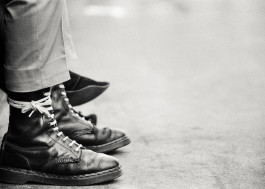FEATURE
Dossier
One of the hazards of adolescence is being misunderstood. It’s also one of the beauties. With the absence of expectation, independence and possibility prevail; rules become the shackles of children and conformists. It is the blink-and-you’ll-miss-it gasp when youthful rebellion vibrates at an elevated frequency just before the world turns on its axis, responsibilities corrode defiance and mementos of mortality obscure youth’s radiance.
Gavin Watson’s Skins photographs—taken in the U.K. in the late ’70s and early ’80s—capture this dazzling anarchy in austere relief. There’s none of the romance or nostalgia typically affixed to the past; his guileless black-and-white snaps are of teenage skinheads. Derided upon arrival and blacklisted by history as racists and fascists, the group was, Gavin asserts, recklessly misunderstood and wildly demonized. “It was never about race,” he maintains. “We were just kids dressing up. It was about friends and music and girls and dancing.”
The kids are the Wycombe Skins, a group of 20 or so boys from a working-class estate called Micklefield in the town of High Wycombe, Buckinghamshire. They weren’t all white, as popular fable prescribes, but they all wore cuffed Levi’s, suspenders, Dr. Marten boots, badges and buttons. Their lives were grim compared to the shiny worlds as seen on TV, to which they aspired. With age, this desire gave way to resentment and the knowing resignation that their lot in life held few opportunities. So the Skins practiced escapism through mischief, mayhem and the rejection of false realities.

Gavin began documenting this transition at the age of 13, with a Hanimex 110 camera bought at Woolworths with Christmas money. He recorded the Skins as they engaged in seditious antics, but also chronicled the quiet moments in between: rides on the Tube or naps in the countryside. He captured the skinhead movement as it passed from naive mutiny to gang warfare and macho posturing, and his dad processed the film in the family bathroom.
What are left behind are poignant pictures that, more than three decades later, Gavin prefers not to view because they are too personally painful. “Memories,” he explains, “disappear for a reason.” Memories might not last forever, but youthful convictions do. They are always there, battling grown-up façades and reminding us of what it means to feel free.

PUBLISHED IN DOSSIER
PHOTOGRAPHY BY GAVIN WATSON
view more
FEATURE
Dossier
One of the hazards of adolescence is being misunderstood. It’s also one of the beauties. With the absence of expectation, independence and possibility prevail; rules become the shackles of children and conformists. It is the blink-and-you’ll-miss-it gasp when youthful rebellion vibrates at an elevated frequency just before the world turns on its axis, responsibilities corrode defiance and mementos of mortality obscure youth’s radiance.
Gavin Watson’s Skins photographs—taken in the U.K. in the late ’70s and early ’80s—capture this dazzling anarchy in austere relief. There’s none of the romance or nostalgia typically affixed to the past; his guileless black-and-white snaps are of teenage skinheads. Derided upon arrival and blacklisted by history as racists and fascists, the group was, Gavin asserts, recklessly misunderstood and wildly demonized. “It was never about race,” he maintains. “We were just kids dressing up. It was about friends and music and girls and dancing.”
The kids are the Wycombe Skins, a group of 20 or so boys from a working-class estate called Micklefield in the town of High Wycombe, Buckinghamshire. They weren’t all white, as popular fable prescribes, but they all wore cuffed Levi’s, suspenders, Dr. Marten boots, badges and buttons. Their lives were grim compared to the shiny worlds as seen on TV, to which they aspired. With age, this desire gave way to resentment and the knowing resignation that their lot in life held few opportunities. So the Skins practiced escapism through mischief, mayhem and the rejection of false realities.

Gavin began documenting this transition at the age of 13, with a Hanimex 110 camera bought at Woolworths with Christmas money. He recorded the Skins as they engaged in seditious antics, but also chronicled the quiet moments in between: rides on the Tube or naps in the countryside. He captured the skinhead movement as it passed from naive mutiny to gang warfare and macho posturing, and his dad processed the film in the family bathroom.
What are left behind are poignant pictures that, more than three decades later, Gavin prefers not to view because they are too personally painful. “Memories,” he explains, “disappear for a reason.” Memories might not last forever, but youthful convictions do. They are always there, battling grown-up façades and reminding us of what it means to feel free.

PUBLISHED IN DOSSIER
PHOTOGRAPHY BY GAVIN WATSON
view more